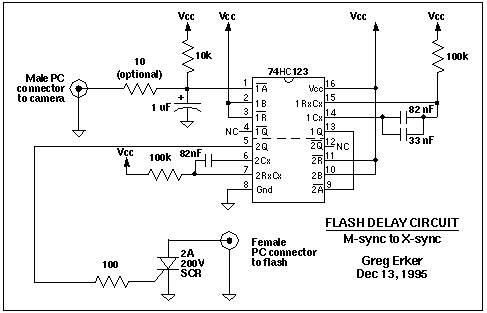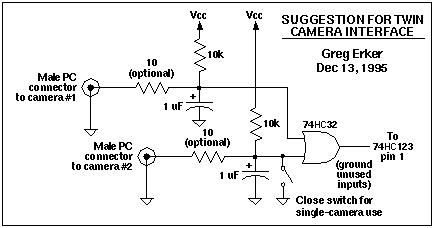
Purpose: This circuit delays the firing of an electronic flash for cameras which have an "M" sync flash connection, but no "X" sync connection. (The M-sync is used with flash bulbs, which have a relatively long delay (several milliseconds) from activation to flash output. Electronic flashes do not have this delay, and if connected to an M-sync directly, flash too soon, often before the shutter has opened).
The circuit uses a 74HC123 to produce a delay so the electronic flash fires when the shutter is open.
The optional 10 ohm resistor will limit the current thru the camera flash contacts to 1/2 amp. This might be necessary to prevent damage to the contacts. I haven't installed this component on my circuit yet.
Channel 1 of the 123 produces a delay which should be long enough that your shutter is fully open. I used 100k and 82 plus 33 nF (115 nF) to get a 10 ms delay which was required for my Ricohflex.
Channel 2 of the 123 is triggered by the end (falling edge) of the delay pulse. It produces a pulse to fire the flash. Its width is probably not critical.
The triggering pulse goes into the gate of an SCR which is connect across the flash leads (using the other end of the PC cord). When the gate is triggered, it turns on, firing the flash. It will continue to conduct until the gate pulse ends AND the current thru it drops below the holding value (depents on SCR, perhaps 5-10 mA).
I originally tried a reed relay to fire the flash but the contacts welded together after one firing (probably due to the 180 volts and high capacitance that my flash appears to have).

My Ricohflex appears to have different amounts of advance (flash to shutter open) at different speeds. The schematic values work at 1/100 shutter speed (all apertures ) and at 1/50 if aperture is f5.6 or smaller.
Adjust yours by looking through the back of the camera at the flash with aperture wide open. Trip shutter and look to see that white flash is round. If you are too early or late you may see a crescent or other shape, depending on the type of shutter your camera has.
Adjust delay by varying resistor and capacitor connected to pins 14 and 15.
An oscilloscope may be useful in debugging the circuit.
My circuit uses about 3 mA (without LED) when on. With an alkaline 9v battery it should last for 100 or 200 hours. A low drop out regulator might work better but I was in a hurry and took what they had available (78L05).
I got a low current (2 mA) LED, to indicate power on, at Radio Shack but haven't wired it in yet. Total current draw will then be about 5 mA.


Build this circuit and connect it to your camera at your own risk. I am not responsible for injury, or damage to your camera or flash.
Comments and questions are appreciated - email Greg Erker. Good luck and good shooting!